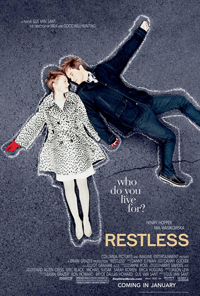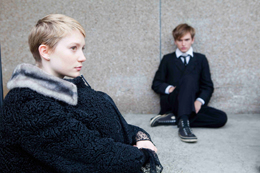Perhaps it is the advance into autumn or the slow approach of winter, but cancer is in the air. With the recent release of “50/50” and now Gus Van Sant’s “Restless,” you’ve got options for stories about people with living with this dreaded disease.
Whereas “50/50” held cancer front and center, making it almost a character, “Restless” uses cancer to compress a lifespan, in order to look at the terminal nature of our human existence.
 In “Restless,” teen orphan, Enoch Brae (Henry Hopper), has lived with his aunt Mabel (Jane Adams) and Hiroshi Takahashi (Ryo Kase), the ghost of a Japanese kamikaze pilot, ever since the violent car crash that killed his parents and left him in a coma for months. Enoch’s weekly routine includes attending the funerals of strangers. At one of these funerals, he meets Annabel Cotton (Mia Wasikowska), a vibrant young woman with an aggressive brain tumor.
In “Restless,” teen orphan, Enoch Brae (Henry Hopper), has lived with his aunt Mabel (Jane Adams) and Hiroshi Takahashi (Ryo Kase), the ghost of a Japanese kamikaze pilot, ever since the violent car crash that killed his parents and left him in a coma for months. Enoch’s weekly routine includes attending the funerals of strangers. At one of these funerals, he meets Annabel Cotton (Mia Wasikowska), a vibrant young woman with an aggressive brain tumor.
If you’re having thoughts of “Harold and Maude,” it is no wonder. Most of “Restless” seems like a younger version of Hal Ashby’s classic awkward, yet touching romance.
Van Sant’s direction is a nice compliment to the content. His loose camera, which seems to live in the same space as the characters, makes us feel as if we are a participants in the scene. It as if we were a concerned loved one in the other room, overhearing a conversation that just might pertain to us.
Much of the dialogue, especially in the early act of the film, is a bit forced or too overt. It is as if screenwriter Jason Lew cannot trust his audience to understand the emotions of each moment. This is a minor gripe, because both Hopper and Wasikowska are great. Each seems to allow their characters to move freely, letting them to grow and explore. Even the more wooden lines of dialogue are some how made passable coming from these two young actors.
And most of the film is quiet. Enoch and Annabel talk quietly on a park bench, walking through a graveyard, walking through the woods. These moments of quiet action fill the story and show us two characters that are trying to cram an entire lifetime of relationship into three short months. The outcome of the story is certain from early on in “Restless,” but this final outcome is less important than how we react to it emotionally when it comes.
 Van Sant creates a beautiful story with the palette of the Pacific Northwest. The grays and blues, oranges and browns serve the introspection and solemnity that comes with exploring our mortality. The only bright colors that show up in the film are from Halloween costumes or various forms of bite sized candies. They are vibrant man-made colors. It is as if Van Sant is using the colors in his film to say that the only hope and joy that comes to us is the hope and joy that we create with each other.
Van Sant creates a beautiful story with the palette of the Pacific Northwest. The grays and blues, oranges and browns serve the introspection and solemnity that comes with exploring our mortality. The only bright colors that show up in the film are from Halloween costumes or various forms of bite sized candies. They are vibrant man-made colors. It is as if Van Sant is using the colors in his film to say that the only hope and joy that comes to us is the hope and joy that we create with each other.
The themes within “Restless” have already been dealt with in arguably better films, but the fact that it brings up vivid comparison to “Harold and Maude” is in itself a testament to Van Sant’s artistry. If you see “Restless” for Wasikowska’s performance alone, it will be worth your time. It is a film that lingers and stays in your head long after you’ve left the theater.







Comments on this entry are closed.